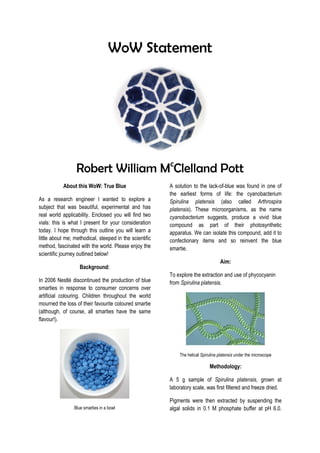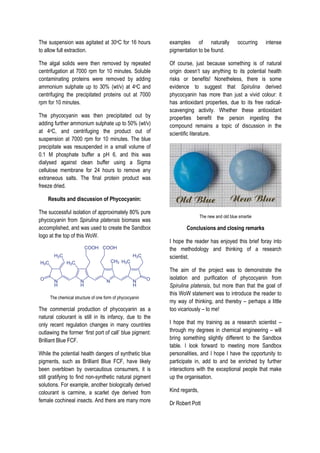Robbie pott
- 1. WoW Statement Robert William Mc Clelland Pott About this WoW: True Blue As a research engineer I wanted to explore a subject that was beautiful, experimental and has real world applicability. Enclosed you will find two vials: this is what I present for your consideration today. I hope through this outline you will learn a little about me; methodical, steeped in the scientific method, fascinated with the world. Please enjoy the scientific journey outlined below! Background: In 2006 NestlÃĐ discontinued the production of blue smarties in response to consumer concerns over artificial colouring. Children throughout the world mourned the loss of their favourite coloured smartie (although, of course, all smarties have the same flavour!). Blue smarties in a bowl A solution to the lack-of-blue was found in one of the earliest forms of life: the cyanobacterium Spirulina platensis (also called Arthrospira platensis). These microorganisms, as the name cyanobacterium suggests, produce a vivid blue compound as part of their photosynthetic apparatus. We can isolate this compound, add it to confectionary items and so reinvent the blue smartie. Aim: To explore the extraction and use of phycocyanin from Spirulina platensis. The helical Spirulina platensis under the microscope Methodology: A 5 g sample of Spirulina platensis, grown at laboratory scale, was first filtered and freeze dried. Pigments were then extracted by suspending the algal solids in 0.1 M phosphate buffer at pH 6.0.
- 2. The suspension was agitated at 30oC for 16 hours to allow full extraction. The algal solids were then removed by repeated centrifugation at 7000 rpm for 10 minutes. Soluble contaminating proteins were removed by adding ammonium sulphate up to 30% (wt/v) at 4oC and centrifuging the precipitated proteins out at 7000 rpm for 10 minutes. The phycocyanin was then precipitated out by adding further ammonium sulphate up to 50% (wt/v) at 4oC, and centrifuging the product out of suspension at 7000 rpm for 10 minutes. The blue precipitate was resuspended in a small volume of 0.1 M phosphate buffer a pH 6, and this was dialysed against clean buffer using a Sigma cellulose membrane for 24 hours to remove any extraneous salts. The final protein product was freeze dried. Results and discussion of Phycocyanin: The successful isolation of approximately 80% pure phycocyanin from Spirulina platensis biomass was accomplished, and was used to create the Sandbox logo at the top of this WoW. The chemical structure of one form of phycocyanin The commercial production of phycocyanin as a natural colourant is still in its infancy, due to the only recent regulation changes in many countries outlawing the former âfirst port of callâ blue pigment: Brilliant Blue FCF. While the potential health dangers of synthetic blue pigments, such as Brilliant Blue FCF, have likely been overblown by overcautious consumers, it is still gratifying to find non-synthetic natural pigment solutions. For example, another biologically derived colourant is carmine, a scarlet dye derived from female cochineal insects. And there are many more examples of naturally occurring intense pigmentation to be found. Of course, just because something is of natural origin doesnât say anything to its potential health risks or benefits! Nonetheless, there is some evidence to suggest that Spirulina derived phycocyanin has more than just a vivid colour: it has antioxidant properties, due to its free radical- scavenging activity. Whether these antioxidant properties benefit the person ingesting the compound remains a topic of discussion in the scientific literature. The new and old blue smartie Conclusions and closing remarks I hope the reader has enjoyed this brief foray into the methodology and thinking of a research scientist. The aim of the project was to demonstrate the isolation and purification of phycocyanin from Spirulina platensis, but more than that the goal of this WoW statement was to introduce the reader to my way of thinking, and thereby â perhaps a little too vicariously â to me! I hope that my training as a research scientist â through my degrees in chemical engineering â will bring something slightly different to the Sandbox table. I look forward to meeting more Sandbox personalities, and I hope I have the opportunity to participate in, add to and be enriched by further interactions with the exceptional people that make up the organisation. Kind regards, Dr Robert Pott


